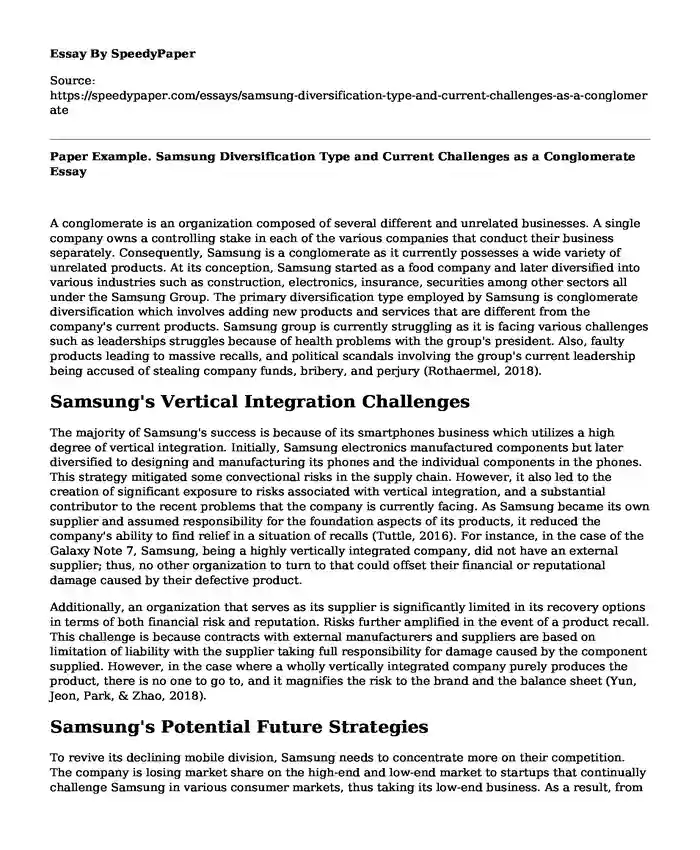
| Type of paper: | Essay |
| Categories: | Branding Samsung Marketing plan Leadership style |
| Pages: | 3 |
| Wordcount: | 604 words |
A conglomerate is an organization composed of several different and unrelated businesses. A single company owns a controlling stake in each of the various companies that conduct their business separately. Consequently, Samsung is a conglomerate as it currently possesses a wide variety of unrelated products. At its conception, Samsung started as a food company and later diversified into various industries such as construction, electronics, insurance, securities among other sectors all under the Samsung Group. The primary diversification type employed by Samsung is conglomerate diversification which involves adding new products and services that are different from the company's current products. Samsung group is currently struggling as it is facing various challenges such as leaderships struggles because of health problems with the group's president. Also, faulty products leading to massive recalls, and political scandals involving the group's current leadership being accused of stealing company funds, bribery, and perjury (Rothaermel, 2018).
Samsung's Vertical Integration Challenges
The majority of Samsung's success is because of its smartphones business which utilizes a high degree of vertical integration. Initially, Samsung electronics manufactured components but later diversified to designing and manufacturing its phones and the individual components in the phones. This strategy mitigated some convectional risks in the supply chain. However, it also led to the creation of significant exposure to risks associated with vertical integration, and a substantial contributor to the recent problems that the company is currently facing. As Samsung became its own supplier and assumed responsibility for the foundation aspects of its products, it reduced the company's ability to find relief in a situation of recalls (Tuttle, 2016). For instance, in the case of the Galaxy Note 7, Samsung, being a highly vertically integrated company, did not have an external supplier; thus, no other organization to turn to that could offset their financial or reputational damage caused by their defective product.
Additionally, an organization that serves as its supplier is significantly limited in its recovery options in terms of both financial risk and reputation. Risks further amplified in the event of a product recall. This challenge is because contracts with external manufacturers and suppliers are based on limitation of liability with the supplier taking full responsibility for damage caused by the component supplied. However, in the case where a wholly vertically integrated company purely produces the product, there is no one to go to, and it magnifies the risk to the brand and the balance sheet (Yun, Jeon, Park, & Zhao, 2018).
Samsung's Potential Future Strategies
To revive its declining mobile division, Samsung needs to concentrate more on their competition. The company is losing market share on the high-end and low-end market to startups that continually challenge Samsung in various consumer markets, thus taking its low-end business. As a result, from an organizational viewpoint, Samsung should strive to reallocate more resources to lower their cost of production, translating to more affordable products for the low-end consumer markets. Such a strategy will allow recapturing their previous low-end market share, mainly from startups (Yun, Jeon, Park, & Zhao, 2018). Additionally, the company should ensure their upcoming high-end products are rigorously tested to avoid any cases of product recalls. As a result, it will help the company in restoring brand confidence.
References
Rothaermel, F. T. (2018). Corporate Strategy: Vertical Integration and Diversification. In F. T. Rothaermel, Strategic Management: Concepts (pp. 264-298). New York: McGraw-Hill Education.
Tuttle, H. (2016, December 1). Samsung's Vertical Integration Challenges. Retrieved from Risk Management: http://www.rmmagazine.com/2016/12/01/samsungs-vertical-integration-challenges /
Yun, J., Jeon, J., Park, K., & Zhao, X. (2018). Benefits and costs of closed innovation strategy: analysis of Samsung's Galaxy Note 7 Explosion and withdrawal scandal. Journal of Open Innovation: Technology, Market, and Complexity, 4(3), 20. https://doi.org/10.3390/joitmc4030020
Cite this page
Paper Example. Samsung Diversification Type and Current Challenges as a Conglomerate. (2023, Feb 15). Retrieved from https://speedypaper.com/essays/samsung-diversification-type-and-current-challenges-as-a-conglomerate
Request Removal
If you are the original author of this essay and no longer wish to have it published on the SpeedyPaper website, please click below to request its removal:
- HR Management Essay Example on Cross-cultural Players in India
- Free Essay Example on Home Safety
- Essay Example on Korea
- Free Essay Sample about Passenger Coaches for Urban and Peril-Urban Center in America
- Free Essay on Babies Born To Drug-Addicted Mothers
- Essay Sample: Hospitality Industry Placement
- Free Essay. the Construction Industry and Its Environmental Impact on Water Quality
Popular categories




